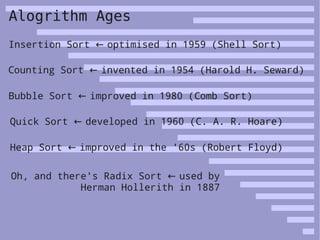Algorithm, Review, Sorting
- 2. Comparing Algorithms Big O notation for: Running Time – best / average / worst Memory Usage 2 1 → n → nlogn → n Also: stability and adaptability
- 3. Insertion Sort Loop through the whole array Compare the current element to the previous one If it's in order, carry on If it's not: Extract it from the array Loop back through the array to find its correct position
- 4. Insertion Sort function insertionSort(array $a) { for ($i = 1; $i < count($a); $i++) { if ($a[$i] > $a[$i-1]) { continue; } $tmp = $a[$i]; $j = $i - 1; while($j >= 0 && $a[$j] > $tmp) { $a[$j+1] = $a[$j]; $j--; } $a[$j+1] = $tmp; } return $a; }
- 5. Insertion Sort Running time Best: O(n) Ave. / Worst: O(n2) Memory usage: O(n) Adaptive, Stable, In-place and On-line
- 6. Bubble Sort Loop through the whole array Compare the current element to the next If they're not in order, swap them round Repeat until no swaps are needed
- 7. Bubble Sort function bubbleSort(array $a) { for ($i = count($a); $i > 0; $i--) { $swapped = false; for ($j = 0; $j < $i-1; $j++) { if ($a[$j] > $a[$j+1]) { $tmp = $a[$j]; $a[$j] = $a[$j+1]; $a[$j+1] = $tmp; $swapped = true; } } if (!$swapped) { return $a; } } }
- 8. Bubble Sort Running time: Best: O(n) Ave. / Worst: O(n2) Memory usage: O(n) "the bubble sort seems to have nothing to recommend it, except a catchy name and the fact that it leads to some interesting theoretical problems" – Donald Knuth More writes, more swaps, etc...
- 9. Quick Sort Divide the array in two, creating a “pivot” value Move any value lower than the pivot to the left array Move any value higher than the pivot to the right array Recursively repeat the same operation on both arrays
- 10. Quick Sort function quickSort(array &$a, $left, $right) { $pivot = $a[ceil(($left + $right) / 2)]; $i = $left; $j = $right; while ($i <= $j) { while ($a[$i] < $pivot) $i++; while ($a[$j] > $pivot) $j--; if ($i <= $j) { $tmp = $a[$i]; $a[$i++] = $a[$j]; $a[$j--] = $tmp; } } if ($left < $j) quickSort($a, $left, $j); if ($i < $right) quickSort($a, $i, $right); return $a; }
- 11. Quick Sort Running time: Best/Ave: O(n log n) Worst: O(n2) Memory usage: O(n) [well sort of...] Easily parallelized Used by PHP's sort() Optimisations on: picking a pivot point, storage options and recursion
- 12. Heap Sort A heap is a specific type of binary tree In a heap, the parent node is always greater than the child If you convert your array to a heap, the root of the heap will be the greatest value Extract that value, then convert the rest of the array to a heap again
- 13. Heap Sort function heapSort(array $a) { $size = count($a); for ($i = round(($size / 2))-1; $i >= 0; $i--) siftDown($a, $i, $size); for ($i = $size-1; $i >= 1; $i--) { $tmp = $a[0]; $a[0] = $a[$i]; $a[$i] = $tmp; siftDown($a, 0, $i-1); } return $a; }
- 14. Heap Sort function siftDown(array &$a, $root, $bottom) { $done = false; while (($root*2 <= $bottom) && (!$done)) { if ($root*2 == $bottom) $maxChild = $root * 2; elseif ($a[$root * 2] > $a[$root * 2 + 1]) $maxChild = $root * 2; else $maxChild = $root * 2 + 1; if ($a[$root] < $a[$maxChild]) { $tmp = $a[$root]; $a[$root] = $a[$maxChild]; $a[$maxChild] = $tmp; $root = $maxChild; } else $done = true; } }
- 15. Heap Sort Running time: O(n log n) ← every time $h = new SplMinHeap(); foreach ($unsorted as $val) $h->insert($val); $h->top(); while($h->valid()) { echo $h->current()."n"; $h->next(); }
- 16. Counting Sort Find the highest and lowest values in the array and calculate the range Create another 0-filled array the size of the range Populate that with a count of the instances of each value in the array Now loop through the values in the range again Populating a final array with the Relevant number of instances of the value
- 17. Counting Sort function countingSort(array $a) { $size = count($a); $min = $max = $a[0]; for($i = 1; $i < $size; $i++) { if ($a[$i] < $min) $min = $a[$i]; elseif ($a[$i] > $max) $max = $a[$i]; } $range = $max - $min + 1; $count = array(); for($i = 0; $i < $range; $i++) $count[$i] = 0; for($i = 0; $i < $size; $i++) $count[ $a[$i] - $min ]++; $z = 0; for($i = $min; $i <= $max; $i++) for($j = 0; $j < $count[ $i - $min ]; $j++) $a[$z++] = $i; return $a; }
- 18. Counting Sort Running time: O(n+c) However, if c is large this is silly Especially on memory usage! Sorting a list of exam grades
- 19. Alogrithm Ages Insertion Sort ← optimised in 1959 (Shell Sort) Counting Sort ← invented in 1954 (Harold H. Seward) Bubble Sort ← improved in 1980 (Comb Sort) Quick Sort ← developed in 1960 (C. A. R. Hoare) Heap Sort ← improved in the '60s (Robert Floyd) Oh, and there's Radix Sort ← used by Herman Hollerith in 1887
- 20. Sorted.




![Insertion Sort
function insertionSort(array $a) {
for ($i = 1; $i < count($a); $i++) {
if ($a[$i] > $a[$i-1]) {
continue;
}
$tmp = $a[$i];
$j = $i - 1;
while($j >= 0 && $a[$j] > $tmp) {
$a[$j+1] = $a[$j];
$j--;
}
$a[$j+1] = $tmp;
}
return $a;
}](https://image.slidesharecdn.com/algorithm-review-sorting-100804073714-phpapp02/85/Algorithm-Review-Sorting-4-320.jpg)


![Bubble Sort
function bubbleSort(array $a) {
for ($i = count($a); $i > 0; $i--) {
$swapped = false;
for ($j = 0; $j < $i-1; $j++) {
if ($a[$j] > $a[$j+1]) {
$tmp = $a[$j];
$a[$j] = $a[$j+1];
$a[$j+1] = $tmp;
$swapped = true;
}
}
if (!$swapped) {
return $a;
}
}
}](https://image.slidesharecdn.com/algorithm-review-sorting-100804073714-phpapp02/85/Algorithm-Review-Sorting-7-320.jpg)


![Quick Sort
function quickSort(array &$a, $left, $right) {
$pivot = $a[ceil(($left + $right) / 2)];
$i = $left;
$j = $right;
while ($i <= $j) {
while ($a[$i] < $pivot) $i++;
while ($a[$j] > $pivot) $j--;
if ($i <= $j) {
$tmp = $a[$i];
$a[$i++] = $a[$j];
$a[$j--] = $tmp;
}
}
if ($left < $j) quickSort($a, $left, $j);
if ($i < $right) quickSort($a, $i, $right);
return $a;
}](https://image.slidesharecdn.com/algorithm-review-sorting-100804073714-phpapp02/85/Algorithm-Review-Sorting-10-320.jpg)
![Quick Sort
Running time:
Best/Ave: O(n log n) Worst: O(n2)
Memory usage: O(n) [well sort of...]
Easily parallelized
Used by PHP's sort()
Optimisations on: picking a pivot point,
storage options and recursion](https://image.slidesharecdn.com/algorithm-review-sorting-100804073714-phpapp02/85/Algorithm-Review-Sorting-11-320.jpg)

![Heap Sort
function heapSort(array $a) {
$size = count($a);
for ($i = round(($size / 2))-1; $i >= 0; $i--)
siftDown($a, $i, $size);
for ($i = $size-1; $i >= 1; $i--) {
$tmp = $a[0];
$a[0] = $a[$i];
$a[$i] = $tmp;
siftDown($a, 0, $i-1);
}
return $a;
}](https://image.slidesharecdn.com/algorithm-review-sorting-100804073714-phpapp02/85/Algorithm-Review-Sorting-13-320.jpg)
![Heap Sort
function siftDown(array &$a, $root, $bottom) {
$done = false;
while (($root*2 <= $bottom) && (!$done))
{
if ($root*2 == $bottom)
$maxChild = $root * 2;
elseif ($a[$root * 2] > $a[$root * 2 + 1])
$maxChild = $root * 2;
else
$maxChild = $root * 2 + 1;
if ($a[$root] < $a[$maxChild]) {
$tmp = $a[$root];
$a[$root] = $a[$maxChild];
$a[$maxChild] = $tmp;
$root = $maxChild;
} else $done = true;
}
}](https://image.slidesharecdn.com/algorithm-review-sorting-100804073714-phpapp02/85/Algorithm-Review-Sorting-14-320.jpg)


![Counting Sort
function countingSort(array $a) {
$size = count($a);
$min = $max = $a[0];
for($i = 1; $i < $size; $i++) {
if ($a[$i] < $min)
$min = $a[$i];
elseif ($a[$i] > $max)
$max = $a[$i];
}
$range = $max - $min + 1;
$count = array();
for($i = 0; $i < $range; $i++)
$count[$i] = 0;
for($i = 0; $i < $size; $i++)
$count[ $a[$i] - $min ]++;
$z = 0;
for($i = $min; $i <= $max; $i++)
for($j = 0; $j < $count[ $i - $min ]; $j++)
$a[$z++] = $i;
return $a;
}](https://image.slidesharecdn.com/algorithm-review-sorting-100804073714-phpapp02/85/Algorithm-Review-Sorting-17-320.jpg)


